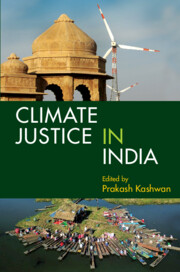Book contents
- Frontmatter
- Contents
- List of Poems and Artworks
- List of Tables
- List of Figures
- List of Abbreviations
- Preface and Acknowledgements
- 1 Introduction: Climate Justice in India
- 2 Urban Climate Justice in India
- 3 How Just and Democratic Is India’s Solar Energy Transition?: An Analysis of State Solar Policies in India
- 4 Extractive Regimes in the Coal Heartlands of India: Difficult Questions for a Just Energy Transition
- 5 Climate Justice Implications of the Relationship between Economic Inequality and Carbon Emissions in India
- 6 Climate Action Plans and Justice in India
- 7 Social Mobilizations for Climate Action and Climate Justice in India
- 8 Reimagining Climate Justice as Caste Justice
- 9 Intersectional Water Justice in India: At the Confluence of Gender, Caste, and Climate Change
- 10 Realizing Climate Justice through Agroecology and Women’s Collective Land Rights
- 11 Conclusion: Pathways to Policies and Praxis of Climate Justice in India
- About the Editor and Contributors
- About the Poets and Artists
- Index
3 - How Just and Democratic Is India’s Solar Energy Transition?: An Analysis of State Solar Policies in India
Published online by Cambridge University Press: 03 November 2022
- Frontmatter
- Contents
- List of Poems and Artworks
- List of Tables
- List of Figures
- List of Abbreviations
- Preface and Acknowledgements
- 1 Introduction: Climate Justice in India
- 2 Urban Climate Justice in India
- 3 How Just and Democratic Is India’s Solar Energy Transition?: An Analysis of State Solar Policies in India
- 4 Extractive Regimes in the Coal Heartlands of India: Difficult Questions for a Just Energy Transition
- 5 Climate Justice Implications of the Relationship between Economic Inequality and Carbon Emissions in India
- 6 Climate Action Plans and Justice in India
- 7 Social Mobilizations for Climate Action and Climate Justice in India
- 8 Reimagining Climate Justice as Caste Justice
- 9 Intersectional Water Justice in India: At the Confluence of Gender, Caste, and Climate Change
- 10 Realizing Climate Justice through Agroecology and Women’s Collective Land Rights
- 11 Conclusion: Pathways to Policies and Praxis of Climate Justice in India
- About the Editor and Contributors
- About the Poets and Artists
- Index
Summary
Introduction
In our warming world, energy provision is not simply about technology but also politics (Hughes and Lipscy 2013). Energy systems are the result of intensely contested political battles in the domains of technology selection, ownership of capital, environmental externalities, access, and siting. The geographical reach, terms of access, and forms of ownership of electricity infrastructures reflect the prevailing distribution of political and economic power (Bridge, Özkaynak and Turhan 2018). Consequently, this gives rise to injustices such as uneven electricity access, displacement, and voicelessness among marginalized communities. Control over energy infrastructure is not just the result but often also the source of political and social power (Amin 2014; Larkin 2013) – that is, energy shapes politics just as much as politics shape energy.
India is facing the twin imperatives of tackling historic energy poverty through an expansion of its energy system on the one hand and pursuing climate mitigation on the other. India's electricity sector is dominated by coal-fired thermal power, which in turn drives the country's carbon emissions. The energy sector as a whole contributed around 74 per cent of India's total greenhouse gas (GHG) emissions in 2015, of which 38 per cent was from public electricity generation (GPI Secretariat 2016). On the other hand, India's average monthly residential electricity consumption is only 90 kilowatt-hour (kWh), which is one-third of the global average and one-tenth of that of the US (Chunekar and Sreenivas 2019). Despite official estimates of 100 per cent electrification, many households still receive poor quality electricity for only a few hours each day (S. D’Souza 2019). The growing feasibility of renewable energy (RE) indicates a potential opportunity to address both climate mitigation and energy poverty challenges. India announced a target of 450 gigawatt (GW) of RE by 2030 as against a total installed capacity of 370 GW in April 2020 (PMO India 2019). As we progress towards a low-carbon system, what are the implications of this transition, given existing patterns of injustice and the prospects of their reproduction in our twenty-first-century energy infrastructure?
India's electricity system can be characterized by its gigantic scale; the primary state ownership of its generation, transmission, and distribution infrastructure; cross-subsidization from commercial and industrial consumers to agricultural consumers; and its federal nature.
- Type
- Chapter
- Information
- Climate Justice in India , pp. 50 - 73Publisher: Cambridge University PressPrint publication year: 2024
- Creative Commons
- This content is Open Access and distributed under the terms of the Creative Commons Attribution licence CC-BY-NC 4.0 https://creativecommons.org/cclicenses/
- 2
- Cited by



